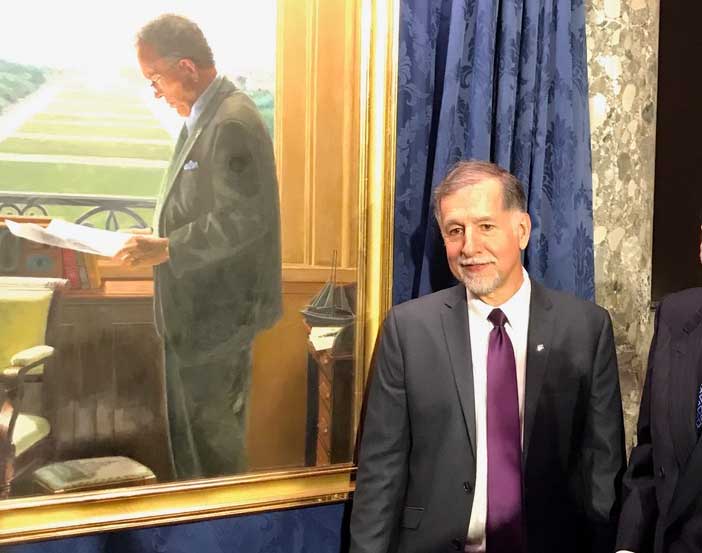By Nina Tabios
In the history books, the late Senate President Pro Tempore Ted Stevens will always be the grouchy champion of Alaska. He had a temper, which many colleagues and former staff attested to at the unveiling of his leadership portrait inside the U.S. Capitol in late October of 2019. But Stevens would only wield his ire—never losing it—as he shaped and upheld the ‘Alaskan Dream’ throughout his 40 years of public service.
In truth, Stevens was bipartisan and pragmatic as he served Alaska from 1968 to 2009. But to a select few like the portrait’s painter Dean Larson, who interned for Stevens in the summers of 1980 and 1981, the senator was also seen as ‘Uncle Ted,’ a man who treated his staff “as extended family.”
“We would see him being grouchy, yelling,” said Larson, a fine art instructor at the Academy of Art University. “But then he’d come back to the office and it was like being with an uncle.”
Larson grew up in Palmer, Alaska, as the son of a state representative, so to paint Stevens for the Senate Leadership Portrait Collection felt “like a once-in-a-lifetime experience.” The opportunity arrived by way of Stevens’ wife Catherine, whom Larson had kept in touch with over the years. Once they ironed out the logistics (including raising private funds), Larson started sketching out ideas.
In the final painting, Senator Stevens is depicted reading a whip count at the window of his office in the Capitol, with the National Mall and Washington Monument visible in the background. To the painter, it just seemed natural to portray Stevens in this way: engaged, thoughtful, and direct in his work, a reflection of Stevens’ commitment to not just Alaska, but the country at large.

“It just seemed more like him,” Larson said. “It seemed more like the way he would want to be remembered—just a quiet moment of the senator at work.”
To paint Stevens was “an honor.” Stevens was one of the first people to venture to the tundra even before it was a state; he fought vigilantly for its statehood and the measures that would protect its land and resources. He would become its third and longest-running senator, who was later named Alaskan of the Century in 2000. Stevens was a stalwart advocate for a state that is over twice the size of Texas but was closer in population numbers to San Francisco.
“A lot of it is tundra and it’s really uninhabitable,” Larson explained. “But still, there’s a lot of it that is incredibly beautiful and people can live and do very well. Senator Stevens made sure of that.”
For over 30 years as a professional, Larson has painted dignified portraits of coveted public figures, musicians, doctors, families, and common folk. As an artist, Larson is playful and perceptive in his compositions, creating incredibly captivating landscapes, cityscapes, and still lifes that have adorned galleries, museums, university and public buildings across the nation, including the Supreme Court of Texas and the United States Institute of Peace in Washington, D.C.
When Larson interned for Stevens in the early 1980s, he was just about to start at the Schuler School of Fine Arts, an atelier-based arts program just outside of Baltimore. At the same time, he also enrolled in the master’s art education program at Towson University. However, teaching wouldn’t come into his life until 2005 when his work caught the eye of the School of Illustration instructor Bill Maughan at the now-shuttered John Pence Gallery in San Francisco. Maughan knew of a place that could use Larson’s knowledge and expertise.
“He gave his card to gallery staff and said, ‘If this artist is ever interested in teaching, come talk to me,’” Larson recalled. At first, he started doing midpoint and final reviews. “Then I got to teach one class. Then two. Then two became three.”
Now, it’s been 14 years and Larson is still teaching landscape and cityscape in the fine art department. He said it’s a nice counterbalance to painting alone in his studio, to be part of “a community of artists” in a “school situation.” But in no way is Larson slowing down when it comes to his art. He paints every day, dedicated to his craft and work, not unlike a beloved senator and legislator from the arctic tundra state up north.
“To have an Alaskan honored in this way is something that has never happened before,” Larson said. “To have that honor was kind of a big deal. And having grown up in Alaska, it meant a lot.”
